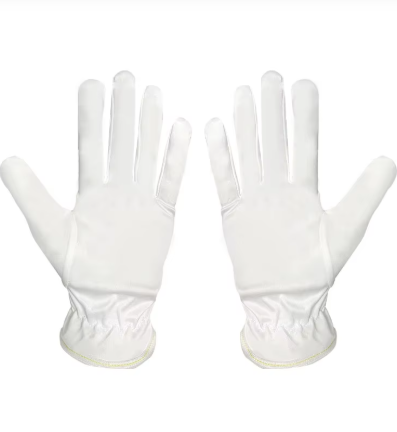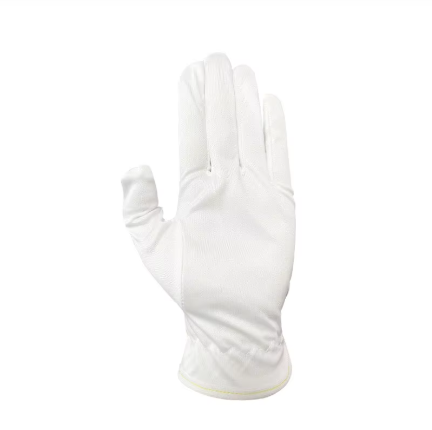अर्धचालक निर्माण र क्लिन पेपर परिशुद्धता
वेफर फेब्रिकेशन: कण एडर्स हटाउनु
वेफर निर्माणको क्रममा वातावरणलाई कणहरूबाट मुक्त राख्नु सेमिकन्डक्टर डिभाइसहरूको उचित कार्यका लागि धेरै महत्वपूर्ण छ। नानी नानी धूलका कणहरूले पनि वेफरलाई खराब पार्न सक्छ, जसले न्यूनतम प्रदर्शन घटाउने देखि लिएर चिपको पूर्ण रूपमा खराब हुनेसम्मको समस्या उत्पन्न गर्न सक्छ। यस्तो समस्यालाई सम्हाल्न, निर्माताहरूले ती कणहरूलाई कम गर्ने कुनै न कुनै तरिका खोज्न आवश्यकता हुन्छ। एउटा उपायको रूपमा मानव हस्तक्षेपको बजाय स्वचालित प्रणालीहरू प्रयोग गर्नु हो, जसले अनायास दूषण घटाउँछ। अर्को तरिका भनेको धूल र अन्य हावामा उड्ने कणहरूलाई संवेदनशील सतहहरूमा खस्नबाट रोक्ने राम्रा फिल्टरहरू स्थापना गर्नु हो। उद्योगको वर्तमान स्थिति हेर्दा, कणहरूको दूषणलाई कम गर्न सक्ने कम्पनीहरूले उत्पादन प्रक्रियामा राम्रा परिणामहरू प्राप्त गरेको पाइन्छ। केही कारखानाहरूले उत्पादनको गुणस्तरमा वास्तविक सुधार देखाएका छन् जब उनीहरूले निर्माण प्रक्रियाको सम्पूर्ण अवधिमा कणहरूको नियन्त्रणमा गम्भीरता देखाएका छन्।
दोष कम गर्नका लागि क्लिनरूम प्रोटोकलहरू
अर्धचालकहरूको उत्पादनमा कम दोष र उत्पादनको गुणस्तर सुधार गर्न हामीले सफा कोठाको नियमहरू पालना गर्नु धेरै महत्वपूर्ण छ। जस्तै हावा कहिले ताजा हुन्छ, तापक्रम नियन्त्रण र आर्द्रता स्तर स्थिर राख्नुले दूषणको समस्या कम गर्न मद्दत गर्दछ। कामदारहरूले छालाका टुक्रा र कर्मचारीहरूको बाललाई कारखानाको सूक्ष्म सञ्चालनमा बाधा पुर्याउन नदिन विशेष उपकरणहरू जस्तै मोटा गाउन र टाइट फिटिङ मास्क लगाउँछन्। धेरै स्थानहरूमा कर्मचारीहरूलाई विभिन्न क्षेत्रहरूमा प्रवेश गर्नुअघि ताजा कपडा लगाउनु पर्ने हुन्छ र सामान खाली गर्न वा हात धोएर निरीक्षण गर्नुपर्ने स्थानहरू हुन्छ। Semiconductor Equipment and Materials International संगठनको रिपोर्ट अनुसार यी सफा कोठाका मापदण्डहरूको पालना गर्ने कम्पनीहरूमा दोषहरू कम हुने देखिन्छ। उत्पादन लागतको दृष्टिकोणबाट यो आजको बजारमा प्रतिस्पर्धात्मक रहन उपयुक्त छ।
SEMI Standards for Particle-Free Environments
SEMI ले स्थापित गरेको मापदण्डले अर्धचालक निर्माण संयन्त्रहरूमा आवश्यक पर्ने अत्यन्तै सफा वातावरण सृजना गर्न व्यावहारिक मार्गदर्शन प्रदान गर्दछ। यी मापदण्डहरू किन यति महत्वपूर्ण छन्? तिनीहरूले मूलतः एक सामान्य ढाँचा सृजना गर्दछन् जसले सुविधाको प्रत्येक कोनामा धूलो र संदूषण नियन्त्रणको दृष्टिकोणबाट न्यूनतम मापदण्ड पूरा गर्न मद्दत गर्दछ। यी मापदण्डहरू पालना गर्न, निर्माताहरूले औपचारिक प्रक्रियाहरू मार्फत प्रमाणीकरण प्राप्त गर्न आवश्यकता हुन्छ जसले सत्यापन गर्दछ कि उनीहरूको क्लिनरूमहरूले विशिष्ट उद्योग द्वारा तय गरिएका मापदण्डहरू पूरा गरेका छन्। वास्तविक संसारको अनुप्रयोगहरू हेर्दा, SEMI प्रोटोकॉलहरू अपनाएपछि धेरै चिप निर्माताहरूले ठोस लाभहरू देखेका छन्। केहीले उत्पादन प्रक्रियाको चक्र छिटो हुनुको रिपोर्ट गर्छन् भने अरूहरूले उनीहरूको उत्पादनमा कम दोषहरू देख्छन्। संचालनलाई चिकनी बनाउने मात्र होइन, यी मापदण्डहरू पालना गर्नाले कम्पनीहरूलाई बजारमा अगाडि बढाउँछ किनकि ग्राहकहरूले निरन्तर गुणस्तर नियन्त्रण अन्तर्गत बनेका उत्पादनहरूमा विश्वास गर्छन्।
फार्मास्युटिकल प्रयोगशालाको GMP सुसंगतता
स्टेराइल उत्पादनमा लिन्ट-मुक्त ब्याच रेकर्ड
औषधि उत्पादनको क्रममा स्टर्इल वातावरण बनाए राख्न लागि ब्याच रेकर्डहरूलाई लिन्ट मुक्त राख्नु अत्यन्तै आवश्यक छ। डकुमेन्टेशन सामग्रीमा लिन्ट कणहरूले वास्तवमा उत्पादनहरूलाई दूषित गर्न सक्छन् र तिनीहरूको स्टेरिलता मापदण्डहरूलाई नष्ट पार्न सक्छ। यो समस्यालाई सम्हाल्नका लागि उद्योगले विशेष रूपमा उपचारित कागजको स्टक र सामान्य ह्यान्डलिङको क्रममा न्यूनतम कणहरू छोड्ने पेनहरूको प्रयोग गर्ने जस्ता विशेष दृष्टिकोणहरू विकसित गरेको छ। यी प्रथाहरूले केवल प्रदूषणका समस्याहरू रोक्ने मात्र होइन, उत्पादन यात्राको प्रत्येक चरणको अधिक प्रभावकारी ढंगले ट्र्याक गर्न मद्दत गर्छन्। GMP आवश्यकताहरूको अन्तर्गत FDA विनियमहरू अनुसार, सफा डकुमेन्टेशन केवल राम्रो प्रथा मात्र होइन, औषधि गुणस्तर नियन्त्रणको लागि आवश्यक छ। उचित रेकर्ड राख्ने काम उपेक्षा गर्ने निर्माताहरूले नियामक दण्ड र उत्पादन सुरक्षाको खतरा दुवै झेल्न सक्छन्।
अडिट-ट्रेसेबल डकुमेन्टेशन प्रथाहरू
फार्मा उत्पादनमा कडा नियामक आवश्यकताहरू पूरा गर्न उचित लेखा विवरण प्रलेखन हुनु आवश्यक छ। यी प्रलेखहरूले कम्पनीहरूलाई उनीहरूको प्रक्रियाका सबै चरणहरू ट्र्याक गर्न र अभिलेखहरू प्रभावकारी ढंगले व्यवस्थित गर्न अनुमति दिन्छ, जुन निरीक्षकहरूले लेखा परीक्षाको समयमा नजिकबाट हेर्छन्। अब धेरै कम्पनीहरूले यसको लागि विशेष डिजाइन गरिएका सफ्टवेयर प्याकेजहरू प्रयोग गर्न थालेका छन्। केही लोकप्रिय विकल्पहरूमा इलेक्ट्रोनिक हस्ताक्षर सुविधाहरू र स्वत: समयमै अपडेटहरूको साथमा बनाइएका सिस्टमहरू समावेश छन् जसले आवश्यकता पर्दा कसैले पनि सबैभन्दा ताजा जानकारी सुलभ गराउँछ। एफडीएले बताएको छ कि राम्रो प्रलेखन प्रथाहरू भएका कम्पनीहरूले परीक्षण तीन दशमलव सम्म पास गर्ने गरेका छन् भन्दा ती कम्पनीहरूको तुलनामा जसले कागजी प्रलेखनमा समस्या भोगेका छन्। लागत व्यवस्थापन गर्दै नियमनको पालन गर्ने प्रयास गरिरहेका फार्मा व्यवसायहरूका लागि ठोस प्रलेखन बुनियादी संरचनामा लगानी गर्नु एक बुद्धिमानीपूर्ण कदम हो जसले नियामक स्वीकृति र संचालन दक्षतामा फाइदा पुर्याउँछ।
सक्रिय सामग्री सँगालोमा प्रदूषक नियन्त्रण
एक्टिभ फार्मास्युटिकल इन्ग्रिडिएन्ट्स (एपीआई) को साथ काम गर्दा दूषित पदार्थहरूलाई नियन्त्रण गर्नु रोगी सुरक्षाको विषयमा चिन्तित औषधि निर्माताहरूको लागि प्राथमिकता हो। उद्योग विशेषज्ञहरूले उत्पादन सुविधाहरूमा कठोर नियन्त्रणका साथै पर्यावरणीय जाँचहरू गर्नुको सुझाव दिएका छन् ताकि अवांछित पदार्थहरू मिश्रणमा नपस्न सकन्। व्यावहारिक दृष्टिकोणहरूमा स्वच्छ कोठाहरूमा कणहरूको गणना नियमित रूपमा जाँच गर्नुका साथै एडभान्स एयर फिल्टरहरू स्थापना गर्नु र आर्द्रता स्तरहरू ध्यानपूर्वक नियमन गर्नु जस्ता कुराहरू समावेश छन्। अनुसन्धानहरूले देखाएको छ कि एपीआईको शुद्धता र अन्तिम औषधि रोगीका लागि सुरक्षित हुने वा हुन नहुने कुरामा स्पष्ट सम्बन्ध छ, जसले गर्दा धेरै कम्पनीहरू दूषण रोक्ने रणनीतिहरूमा ठूलो लगानी गर्छन्। आफ्नो प्रतिष्ठा सुरक्षित राख्दै नियमनको पालना गर्न चाहने फार्मा कम्पनीहरूका लागि सम्भावित दूषकहरू प्रबन्ध गर्दा विवरणमा ध्यान दिनु न केवल राम्रो अभ्यास हो, यो नियामक पालना र प्रभावकारी उपचार प्रदान गर्नका लागि पनि पूर्ण रूपमा आवश्यक छ।
चिकित्सा उपकरण स्टेरिलाइजेसन प्रोटोकॉल
शल्यक्रिया औजारहरूका लागि ISO वर्ग 5 प्याकेजिङ
ISO वर्ग 5 प्याकेजिङ मानकहरूले शल्यक्रिया उपकरणहरूलाई स्टेराइल राख्न महत्वपूर्ण भूमिका खेल्छन्। यी निर्देशहरूले उपकरणमा जीवाणुहरू प्रवेश गर्न नदिने विशिष्ट सफाई आवश्यकताहरू निर्धारित गर्छन्, जसले गर्दा सञ्चालनको क्रममा बिरामीहरूको सुरक्षा गर्छ। सामग्रीको कुरा गर्दा, विशेष प्लास्टिकका पर्तहरू र केही धातु भागहरूले दूषित हुनबाट बचाउने महत्वपूर्ण अवरोधको रूपमा कार्य गर्छन्। विश्व स्वास्थ्य संगठनबाट लिइएको अनुसन्धानले देखाएको छ कि कडा स्टेरिलाइजेसन नियमहरू पालना गर्ने अस्पतालहरूमा संक्रमणको दर धेरै कम छ भन्दा ती अस्पतालहरूको तुलनामा जहाँ ती नियमहरू पालना गरिएन। यसैले, ISO वर्ग 5 मानकहरू पालना गर्नु अनुशंसित मात्र होइन, बरु कुनै अस्पतालका लागि शल्यक्रियासँग जोडिएका संक्रमणहरू घटाउन आवश्यक छ। अन्ततः, उचित प्याकेजिङ नबनाएको कारणले जटिलताहरू उत्पन्न हुन चाहने कोही पनि हुँदैन।
एसेप्टिक ट्रान्सफरमा सफा कागजको भूमिका
मेडिकल डिभाइस उत्पादनमा, सफा कागजले एसेप्टिक स्थानान्तरणको समयमा अवांछित प्रदूषकहरूको विरुद्धमा सुरक्षा पर्तको रूपमा कार्य गर्ने कारणले यसको महत्वपूर्ण भूमिका रहन्छ। यस सामग्रीलाई विशिष्ट बनाउने कुरा यसका केही विशेषताहरू जस्तै न्यूनतम धूल उत्पादन र कडा सफाइ आवश्यकताहरू हुन् जसले सबै कुरालाई स्टर्इल राख्नमा सहयोग पुर्याउँछन्। संवेदनशील उपकरणहरूको प्रयोग गर्दा सफा कागजको प्रयोगले पछि जैविक जोखिमहरू सिर्जना गर्न सक्ने सम्भावित प्रदूषणका समस्याहरूलाई रोक्न मद्दत पुर्याउँछ। प्रयोगशालामा सञ्चालित अध्ययनहरूले पनि यसलाई समर्थन गरेका छन्, केही परीक्षणहरूले सफा कागज प्रोटोकलहरू लागू गरेपछि माइक्रोबहरूको संख्या लगभग 40% कम देखिएको उल्लेख छ। स्टर्इल वातावरणमा काम गर्ने कसैको लागि पनि उत्पादनका सबै चरणहरूमा उत्पादको गुणस्तर बनाए राख्न खाली रूपमा मात्र राम्रो अभ्यास नभई सफा कागजलाई मानक सञ्चालन प्रक्रियाहरूमा समावेश गर्नु आवश्यक छ।

स्टेरिलिटी आश्वासनका लागि प्रमाणीकरण प्रक्रियाहरू
मेडिकल उपकरणहरूलाई स्टर्इल राख्नका लागि कडा सत्यापन प्रक्रियाहरू राख्नु निकै महत्वपूर्ण छ। वास्तविक प्रक्रियाहरूमा जैविक बर्डेन (bioburden) जाँच गर्ने र जीवाणु एन्डोटक्सिनहरू (bacterial endotoxins) हेर्ने जस्ता केही परीक्षणहरू समावेश छन्, जुन हामीलाई वस्तुहरू कति स्टर्इल छन् भन्ने बताउँछ र केही गलत भएमा के सुधार गर्नुपर्छ भन्ने पनि बताउँछ। पहिलो पटकको सत्यापन पछि, स्टर्इलता मानकहरूसँग अनुपालन गर्नका लागि निरन्तर निगरानी मार्फत काम गर्न आवश्यकता हुन्छ। ISO जस्ता संस्थाहरूबाट उद्योगका मार्गनिर्देशहरूले निरन्तर उचित स्टर्इलिजेसनको महत्वलाई जोड दिन्छन् ताकि निरन्तर राम्रो परिणामहरू प्राप्त गरिएको होस्। जब हामी यी सत्यापनहरू नियमित रूपमा चलाउँछौं, हामी वास्तवमा माइक्रोबहरूको मिश्रणमा जाने सम्भावनालाई कम गर्दैछौं, जसले मरीजहरूको सुरक्षा गर्छ र हाम्रो मेडिकल उपकरणहरू प्रयोग गर्न सुरक्षित रहन्छ भन्ना सुनिश्चित गर्छ।
एयरोस्पेस एभियोनिक्स असेम्बली आवश्यकताहरू
उडान महत्वपूर्ण प्रणालीहरूमा एफओडी रोकथाम
एभियोनिक्स असेम्बलीको समयमा विदेशी वस्तु मलबारोक (FOD) रोक्नु धेरै महत्वपूर्ण छ किनभने धूलो वा धातुका साना टुक्राले उडान सम्बन्धी महत्वपूर्ण प्रणालीहरूलाई समस्यामा पार्न सक्छ। अधिकांश निर्माताहरू उत्पादनको क्रममा विस्तृत सफाइ नियम र नियमित जाँचबिचको सहाराले कामको क्षेत्रलाई सफा राख्छन्। केही कम्पनीहरूले थप कदम चाली उपकरणहरूको नियमित रखरखाव गर्ने तथा साना कणहरूलाई समस्यामा पर्नुअघि नै छल्न मद्दत गर्न विशेष उपकरणहरूमा लगानी गर्छन्। हालका उद्योग सम्बन्धी प्रतिवेदनहरूका अनुसार, FOD सँग सम्बन्धित समस्याले हरेक वर्ष हवाई कम्पनीहरूलाई करोडौंको नोक्सानी पुर्याउँछ भने यात्रु र कर्मचारीहरूका लागि वास्तविक खतरा पनि सिर्जना गर्छ। त्यसैले धेरै विमानन कम्पनीहरूले FOD रोकथामलाई दैनिक नियमको रूपमा अपनाएका छन् जुन केवल तबको लागि मात्र होइन जब केही गलत हुने गरेको हुन्छ।
घटक ट्रेसेबिलिटीका लागि क्लिनरूम पेपर
अख्खा एयरोस्पेस समाबेशन प्रक्रियामा भागहरू ट्र्याक गर्न लिएर क्लिनरूम पेपर वास्तवमै महत्वपूर्ण छ। यो कागजलाई विशेष बनाउने कुरा के हो भने? यसले धेरै धूल उत्पादन गर्दैन र दूषित पदार्थबाट मुक्त रहन्छ, जुन ती सुपर साफा उत्पादन स्थानहरूमा धेरै महत्वपूर्ण हुन्छ। जब कम्पनीहरूले क्लिनरूम कागज प्रयोग गर्छन्, तिनीहरूले समाबेशन लाइनहरू मार्फत सामग्रीको आवागमन हुँदा प्रत्येक घटकमा विस्तृत रेकर्ड राख्न सक्छन्। यस्तो प्रलेखनले प्रत्येकलाई आफ्नो काममा जिम्मेवार बनाउँछ र गल्तीहरू हुने सम्भावना कम गर्छ। सुरक्षा पनि राम्रो हुन्छ किनभने भागहरू भ्रमित हुने वा केही महत्वपूर्ण कुरा छुट्ने सम्भावना कम हुन्छ। एयरोस्पेस उद्योग भरमा, निर्माताहरूले यी क्लिनरूम सामग्रीहरूलाई आफ्नो कार्यप्रवाहमा समावेश गर्दा समस्याहरू खोज्न धेरै छिटो भएको पाएका छन्। यदि समाबेशनको क्रममा केही गलत हुन्छ भने, प्राविधिकहरूले तुरुन्तै यो पत्ता लगाउन सक्छन् कि कहाँबाट कुरा गलत भयो र उत्तरहरूको खोजीमा घण्टौं बर्बाद नगरी सच्याउन सक्छन्।
प्रिसिजन असेम्बलीमा AS9100 अनुपालन
एएस ९१०० मानकहरू वायु उड्डयन उपकरणहरू बनाउनमा महत्वपूर्ण भूमिका निभाउँछन्, गुणस्तर नियन्त्रण बनाए राख्नका लागि एउटा नक्साको रूपमा काम गर्दै जब लगातार सुधारका तरिकाहरू खोज्दै। जब कम्पनीहरूले एएस ९१०० का मार्गनिर्देशनहरूको पालना गर्छन्, त्यहाँ उत्पादन गुणस्तर र सुरक्षामा सुधार देखिन्छ विमानका भागहरूको निर्माणकालमा। धेरै कम्पनीहरूले एएस ९१०० अन्तर्गत प्रमाणीकरण पछि कार्यशालामा पनि वास्तविक सुधार देखेका छन् - ग्राहकहरू सामान्यतया सन्तुष्ट हुन्छन्, कार्यप्रणाली सजिलो हुन्छ, र उत्पादनमा त्रुटिको सम्भावना कम हुन्छ। यी मानकहरूको पालना गर्नु भनेको भागहरूले निरन्तर वायु उड्डयन प्राधिकरणहरूले आवश्यक पर्ने कठिन सुरक्षा मापदण्डहरू पूरा गर्नु हो, जसले ग्राहकहरू र नियामकहरू दुवैको विश्वास जित्छ। सम्पूर्ण वायु उड्डयन क्षेत्रका प्रमुख खेलाडीहरूले समयको साथ एएस ९१०० अपनाएका छन्, यसले साना भागहरूदेखि लिएर पूरा विमान प्रणालीहरूसम्म सबैमा उच्च मानकहरू बनाए राख्न मद्दत गर्छ भन्ने कुराको स्वीकृति गर्दै।
खाद्य सुरक्षा र गुणस्तर आश्वासन प्रयोगहरू
अल्ट्रा-क्लिन मिडियाको साथमा सूक्ष्मजीव नमूना लिने
सूक्ष्मजीव नमूना लिने क्रममा अत्यन्त शुद्ध सामग्री प्रयोग गर्नाले खाद्य सुरक्षा परीक्षणमा विश्वसनीय परिणाम प्राप्त गर्नमा ठूलो फरक पार्छ। जब नमूनाहरू उचित रूपमा सङ्कलन गरिन्छ, त्यहाँ वास्तवमा नभएका संदूषकहरू पत्ता लगाउने सम्भावना कम हुन्छ, जसले गर्दा खाद्य आपूर्तिमा सम्भावित जोखिमहरूको बारेमा गलत चेतावनीहरू कम हुन्छन्। प्रयोगशालाहरूले सबै केही चिसो राख्नका लागि सख्त प्रोटोकलहरू अनुसरण गर्ने गर्छन् - उपकरणहरू पहिलो कुरा मात्रै स्टेरलाइज गरिन्छ, त्यसपछि प्राविधिकहरूले नमूनाहरूलाई दस्तानेमा हातले समाप्त गर्छन् र बाहिरी जीवाणुहरू मिसाउन बाहिर ल्यामिनार फ्लो हुडहरू अन्तर्गत काम गर्छन्। उद्योगका रिपोर्टहरूले देखाएको छ कि जब प्रयोगशालाहरूले यी सफाई मानकहरूलाई टिकाउँछन्, त्यहाँ उनीहरूको परीक्षणमा धेरै कम अवांछित सूक्ष्मजीवहरू पाइन्छन्, जसले गर्दा सम्पूर्ण प्रक्रिया धेरै सटीक बनाउँछ। खाद्य उत्पादकहरूका लागि, यस्तो सटीकता केवल राम्रो विज्ञान मात्र होइन, यो ग्राहकहरूलाई फर्केर आउन प्रेरित गर्ने कुरा हो किनकि कुनैले पनि बिरामी पार्न सक्ने उत्पादनहरू किन्न चाहँदैनन्।
प्रसंस्करण लाइनहरूमा HACCP कागजातीकरण
हेजार्ड एनालिसिस र क्रिटिकल कण्ट्रोल प्वाइन्ट (एचएसीसीपी) प्रणालीमा राम्रो रेकर्ड राख्नु उत्पादनको क्रममा खाद्य सुरक्षा बनाए राख्नका लागि निकै महत्वपूर्ण छ। जब व्यवसायहरूले विस्तृत रेकर्डहरू राख्छन्, त्यो नियमहरूको पालना गर्न र यदि केही गलत भएमा समस्याहरू पत्ता लगाउन सजिलो बनाउँछ। लिखित एचएसीसीपी योजनाहरू निर्देशिकाको रूपमा काम गर्छन् जसले सम्भावित जोखिमहरू पहिचान गर्न र संदूषण रोक्न के कदमहरू चाहिन्छन् भनेर निर्धारण गर्न मद्दत गर्छ। खाद्य सुरक्षा विशेषज्ञहरूले जोड दिएका छन् कि उचित कागजातीकरणले एचएसीसीपी प्रणाली निर्माणमा ठूलो फरक पार्छ। राम्रो रेकर्ड बिना महत्वपूर्ण जानकारी उलेको हुन्छ वा पूर्ण रूपमा गायब हुन्छ, जसले उत्पादन लाइनमा समस्याहरू उत्पन्न गर्छ र वास्तविक सुरक्षा जोखिमहरू सिर्जना गर्छ। यी विस्तृत रेकर्डहरूले पनि कम्पनीहरूलाई खाद्य सुरक्षा सम्बन्धी चिन्ताको सामना गर्दा छिटो प्रतिक्रिया गर्न सक्षम बनाउँछ, जसले खाद्य सुरक्षा प्रबन्धमा कागजातीकरणको महत्वलाई समस्याहरू घट्नु अघि नै देखाउँछ।
फिल्टर्ड एनालिसिस मार्फत एलर्जन नियन्त्रण
फिल्टर गरिएको विश्लेषण तरिकाले खाना उत्पादन संयन्त्रहरूमा एलर्जी सम्बन्धी समस्याहरूलाई सम्हाल्ने नयाँ तरिका प्रस्तुत गर्दछ जहाँ सदैव क्रस कन्टामिनेसनको चिन्ता रहन्छ। यो प्रणालीले काम गर्दछ उच्च फिल्टर उपकरण प्रयोग गरेर जसले उत्पादनका विभिन्न क्षेत्रहरूमा फैलिन सक्ने नानी एलर्जीक निलम्बित कणहरूलाई छुट्याउँछ, जसले गर्दा सम्पूर्ण सञ्चालन सुरक्षित हुन्छ। खाद्य उत्पादकहरूले आजकल HEPA फिल्टर जस्ता चीजहरू स्थापना गर्ने गरेका छन् किनभने त्यस्ता फिल्टरहरूले सूक्ष्म एलर्जीक पदार्थहरूलाई पकड्छन् जुन अन्यथा एलर्जी मुक्त हुनुपर्ने अन्तिम उत्पादनहरूमा जान सक्छन्। उद्योगको तथ्याङ्कले यो फिल्टर गर्ने दृष्टिकोणले एलर्जी नियन्त्रणमा प्रभावकारी भूमिका निभाएको देखाउँछ, जसले गर्दा विशेष आहारको आवश्यकता पर्ने व्यक्तिहरूमा अप्रिय एलर्जी प्रतिक्रियाहरू कम भएका छन्। यी आधुनिक फिल्टर समाधानहरू अपनाउने निर्माताहरूले सार्वजनिक स्वास्थ्यको रक्षा गर्नुको साथै ग्राहकहरूको विश्वास जित्छन् जो सही लेबल र सुरक्षित खाद्य व्यवहारको आशा गर्दछन्।
क्रस-उद्योग कन्टामिनेसन नियन्त्रण मापदण्ड
ISO 14644 क्लिनरूम वर्गीकरण मापदण्डहरू
ISO 14644 क्लिनरूम वर्गीकरण प्रणालीले धेरै उद्योगहरूका लागि महत्वपूर्ण आधारभूत संरचना प्रदान गर्दछ जसले दूषणलाई नियन्त्रण गर्नुपर्छ। यी मानकहरू कणहरूको मात्राको आधारमा क्लिनरूमहरूलाई वर्गीकृत गर्दछ, जसले सेमिकन्डक्टर उत्पादन र औषधि निर्माण जस्ता क्षेत्रहरूमा अत्यन्त नियन्त्रित वातावरणमा कार्य गर्न सक्षम बनाउँछ। उदाहरणका लागि सेमिकन्डक्टर निर्माणको लिनुहोस्, अधिकांश चिप निर्माताहरू क्लास 1 क्लिनरूममा काम गर्दछन् किनकि सूक्ष्म कणहरूले नै नाजुक घटकहरूलाई उत्पादनको क्रममा खराब गर्न सक्छ। औषधि कम्पनीहरूले पनि समान मापदण्डहरूमा भरोसा गर्छन्, किनकि कुनै पनि दूषणले औषधिको सुरक्षा र प्रभावकारितालाई खतरामा पार्न सक्छ। Intel र Pfizer जस्ता प्रसिद्ध कम्पनीहरूले पनि यी निर्देशनहरू कडाईले पालना गर्छन्। परिणाम? दूषणमा रहेको नियन्त्रणले सीधा प्रविधि र स्वास्थ्य सेवा क्षेत्रमा उच्च गुणस्तरका उत्पादनहरू उत्पादन गर्न मद्दत गर्दछ।
रासायनिक वातावरणमा पदार्थ सामग्री सामंजस्यता
प्रतिक्रियाशील दूषणका समस्याहरूलाई रोक्नका लागि क्लिनरूमका लागि सही सामग्रीहरू प्राप्त गर्नु धेरै महत्वपूर्ण छ। सामग्रीहरू छान्दा कम्पनीहरूलाई त्यस्ता सामग्रीहरूको आवश्यकता पर्दछ जुन वातावरणमा उडिरहेका रसायनहरूको सामना गर्न सक्छन् बिना नै नष्ट हुने वा दूषकहरूलाई वातावरणमा छिर्न दिने। अधिकांश उद्योग मानकहरूले नॉन-रिएक्टिभ विकल्पहरूलाई सङ्केत गर्छन् जुन नियमित रूपमा प्रयोग गरिने सफाइ एजेन्टहरूको सामना गर्न सक्छन्। इन्डस्ट्रियल हाइजीन जर्नलको अनुसन्धानले वास्तवमै गलत सामग्री छान्नुका कारण ठूला दूषणका समस्याहरू भएका र उत्पादनहरूका ब्याचहरू नष्ट भएका अवस्थाहरू पाएको छ, जसले यो चयन प्रक्रियामा ध्यान दिनु आवश्यक छ भन्ने कुरालाई जोड दिन्छ। त्यसैले सामग्री सामंजस्यता केवल रखरखाव टोलीहरूले मात्र चिन्ता लिने कुरा होइन, यसले दैनिक सञ्चालनबाट लिएर अप्रत्याशित बन्द वा खराब सुरक्षा घटनाहरूको सम्भावनालाई पनि असर गर्छ।
प्रेसिजन क्लिन पेपर्सको जीवन चक्र प्रबन्धन
विभिन्न उद्योगहरूमा सफा कागजहरूको जीवन अवधि प्रबन्धन गर्नु धेरै महत्वपूर्ण छ जब सम्म यो स्वच्छता बनाई राख्न र वातावरणको मैत्रीपूर्ण होना आवश्यक हुन्छ। पूरा प्रक्रियाले सही ह्यान्डलिङ्ग प्रथाहरू, स्पष्ट प्रयोग गर्ने निर्देशनहरू र जिम्मेवार निपटानको आवश्यकता पर्दछ ताकि यी विशेष कागजहरूले उनीहरूको उद्देश्य पूरा गर्न सकून र हाम्रो ग्रहका लागि थप समस्याहरू सिर्जना नगरून। अहिले धेरै व्यवसायहरूले आफ्ना सफा कागजहरू पुनःचक्रण गरिएको सामग्री वा अन्य स्थायी स्रोतहरूबाट बनाउन प्राथमिकता दिन्छन्, जसले प्रकृतिलाई सुरक्षित राख्न विश्वव्यापी प्रयासहरूमा राम्रो तरिकाले फिट हुन्छ। सफा कागज बजारमा एक प्रमुख खेलाडीबाटको एउटा सम्प्रति अध्ययनले देखाएको छ कि हरियो विकल्पहरूमा सार्नुले पर्यावरणीय क्षतिलाई काफी हदसम्म कम गर्दछ, दुवै फोहोर निर्माणलाई कम गर्दछ र कम्पनीहरूलाई उनीहरूको हरियो प्रतिबद्धता पूरा गर्न मद्दत गर्दछ। यी कागजहरूलाई उनीहरूको सम्पूर्ण जीवन अवधिमा कसरी ह्यान्डल गरिन्छ भन्ने कुराले व्यवसायको लागि मात्र होइन भविष्यका पुस्ताहरूले स्वस्थ पृथ्वी विरासतमा पाउनका लागि पनि अर्थपूर्ण छ।
FAQ खण्ड
सफ्याउँदो पेपर के हो?
सफा कागजलाई कण उत्पादन कम गर्न र उच्च सफाई मापदण्डहरूको लागि विशेष रूपमा डिजाइन गरिएको कागजको रूपमा परिभाषित गरिएको छ, जसलाई सेन्टिटिभ वातावरणमा दूषण रोक्न प्रयोग गरिन्छ, जस्तै एसेप्टिक ट्रान्सफर वा सेमिकन्डक्टर उत्पादन।
सेमिकन्डक्टर उत्पादनमा सफा कागजले कसरी योगदान पु¥याउँछ?
सफा कागजले कण मुक्त वातावरण बनाए राख्दछ, जसले गर्दा वेफर निर्माणको क्रममा दोषहरू कम हुन्छ र उच्च उत्पादन गुणस्तर र उपज सुनिश्चित गर्दछ।
मेडिकल डिभाइस उत्पादनमा सफा कागज किन महत्वपूर्ण छ?
सफा कागजले दूषकहरूको बाधा को रूपमा काम गर्दछ, जसले गर्दा मेडिकल डिभाइसहरू ह्यान्डलिङ र सार्ने क्रममा दूषित नहुने गरी सुनिश्चित गर्दछ, जसले गर्दा सूक्ष्मजीविक दूषणको जोखिम कम हुन्छ।
कुन कुन उद्योगहरूले सफा कागजको प्रयोग गर्छन्?
सेमिकन्डक्टर उत्पादन, मेडिकल डिभाइस उत्पादन, एयरोस्पेस, फार्मास्युटिकल्स र खाद्य उत्पादन जस्ता उद्योगहरूले उच्च सफाई मापदण्डहरू बनाए राख्न र दूषण रोक्न सफा कागजको प्रयोग गर्छन्।
एयरोस्पेस असेम्बलीमा सफा कागज कसरी प्रयोग गरिन्छ?
वायुगति संचालनमा, सफा कोठाको कागजले घटकहरूको दस्तावेजीकरण र ट्रेसेबिलिटी सुनिश्चित गर्दछ, जिम्मेवारी बढाउँछ र संकलन प्रक्रियाको क्रममा त्रुटि दर कम गर्दछ।
सफा कागज प्रयोग गर्ने स्थायी लक्ष्यहरूमा सहयोग पुर्याउँछ?
हो, कम्पनीहरूले पुन:चक्रित वा स्थायी सामग्रीबाट सफा कागजहरूको स्रोत प्राप्त गर्न सक्छन्, जो पर्यावरण मैत्री अभ्यास र कर्पोरेट जिम्मेवारीको पहलमा योगदान पुर्याउँछ।
विषय सूची
-
अर्धचालक निर्माण र क्लिन पेपर परिशुद्धता
- वेफर फेब्रिकेशन: कण एडर्स हटाउनु
- दोष कम गर्नका लागि क्लिनरूम प्रोटोकलहरू
- SEMI Standards for Particle-Free Environments
- फार्मास्युटिकल प्रयोगशालाको GMP सुसंगतता
- स्टेराइल उत्पादनमा लिन्ट-मुक्त ब्याच रेकर्ड
- अडिट-ट्रेसेबल डकुमेन्टेशन प्रथाहरू
- सक्रिय सामग्री सँगालोमा प्रदूषक नियन्त्रण
- चिकित्सा उपकरण स्टेरिलाइजेसन प्रोटोकॉल
- शल्यक्रिया औजारहरूका लागि ISO वर्ग 5 प्याकेजिङ
- एसेप्टिक ट्रान्सफरमा सफा कागजको भूमिका
- स्टेरिलिटी आश्वासनका लागि प्रमाणीकरण प्रक्रियाहरू
- एयरोस्पेस एभियोनिक्स असेम्बली आवश्यकताहरू
- उडान महत्वपूर्ण प्रणालीहरूमा एफओडी रोकथाम
- घटक ट्रेसेबिलिटीका लागि क्लिनरूम पेपर
- प्रिसिजन असेम्बलीमा AS9100 अनुपालन
- खाद्य सुरक्षा र गुणस्तर आश्वासन प्रयोगहरू
- अल्ट्रा-क्लिन मिडियाको साथमा सूक्ष्मजीव नमूना लिने
- प्रसंस्करण लाइनहरूमा HACCP कागजातीकरण
- फिल्टर्ड एनालिसिस मार्फत एलर्जन नियन्त्रण
- क्रस-उद्योग कन्टामिनेसन नियन्त्रण मापदण्ड
- ISO 14644 क्लिनरूम वर्गीकरण मापदण्डहरू
- रासायनिक वातावरणमा पदार्थ सामग्री सामंजस्यता
- प्रेसिजन क्लिन पेपर्सको जीवन चक्र प्रबन्धन
- FAQ खण्ड




